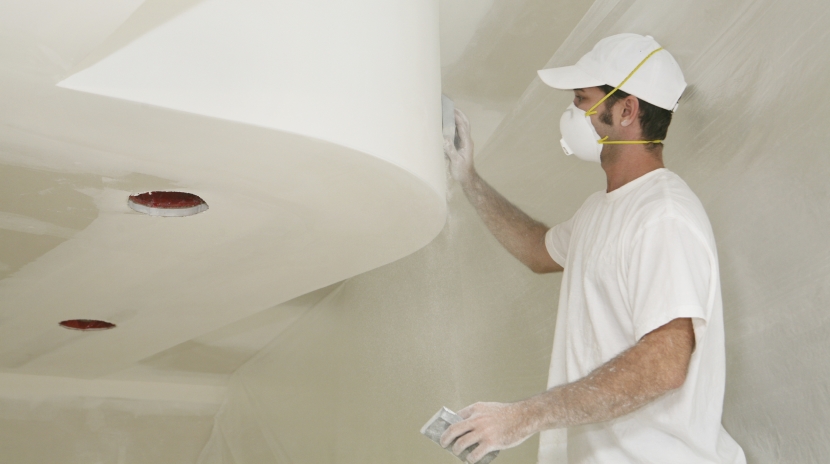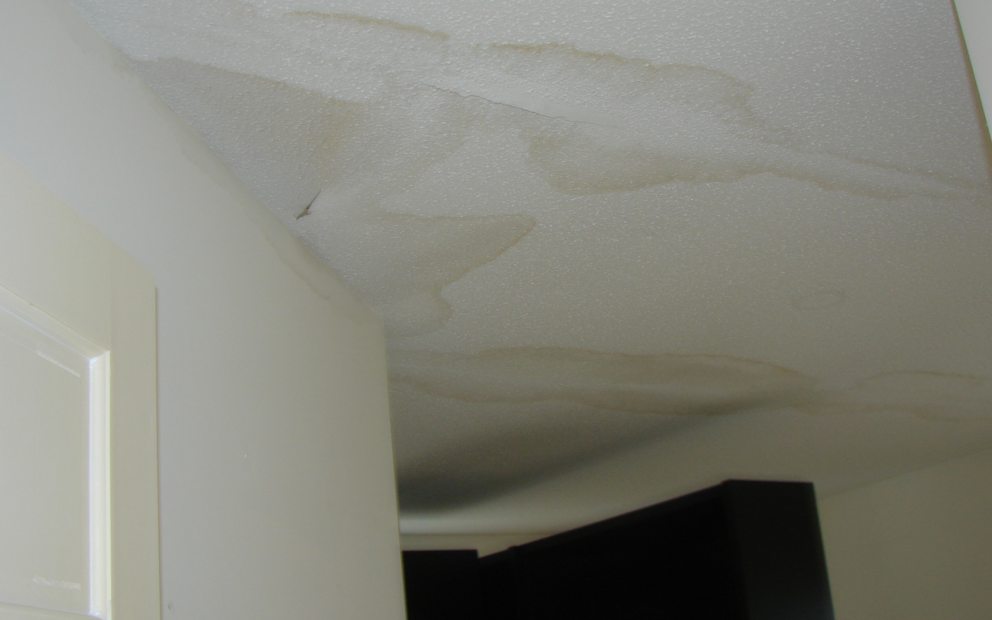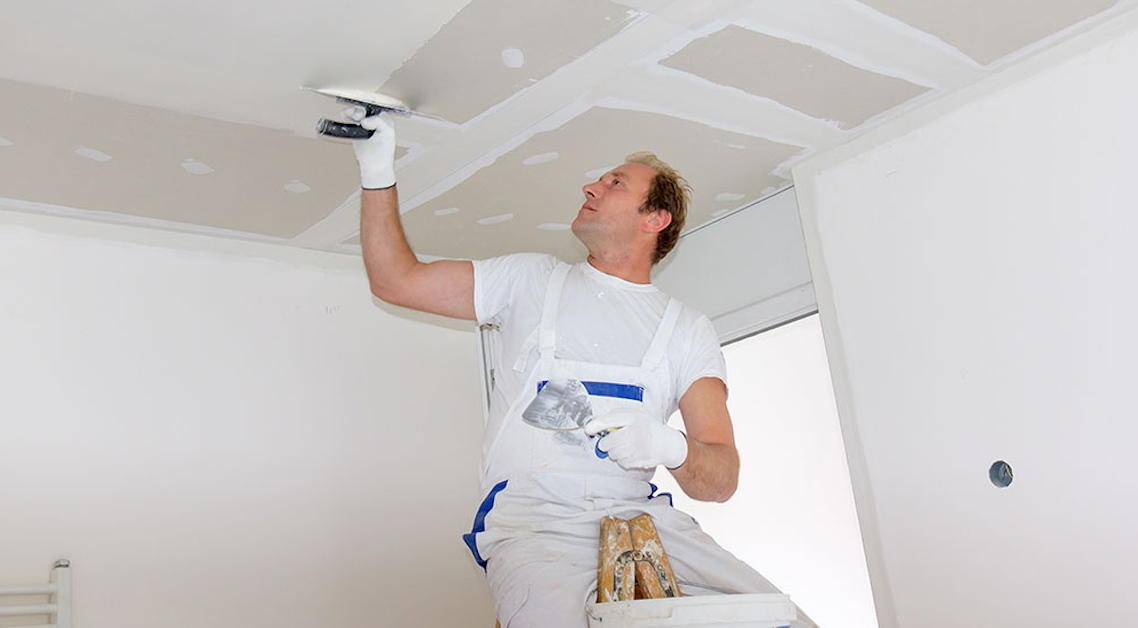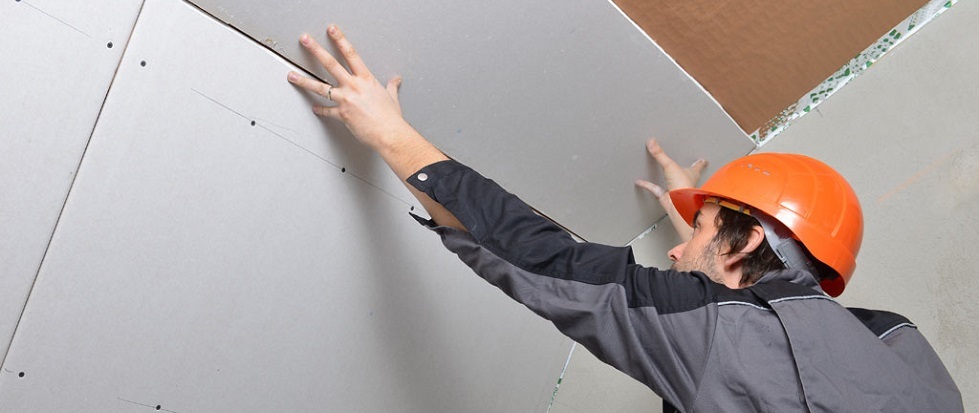If you have noticed water damage on your ceiling, it’s important that you repair the issue for the health and safety of your household. Water damage that is left unaddressed can lead to mould growth, a weakened ceiling and more costly damage in the future.
What causes water damage on your ceiling?
Water damage on ceilings can be caused by a number of issues including condensation, plumbing leaks, burst pipes and roof damage. To identify the problem, start by examining what is above the leak. Whether it’s an upstairs bathroom, damage on your roof or clogged gutters, whatever is above the ceiling damage is often the cause.
Here are the most common causes of ceiling water damage:
1. Condensation
Rooms that have high humidity, such as your bathroom or kitchen, are particularly susceptible to ceiling damage. The moisture in the air can cause mould and mildew stains to appear. To avoid this kind of damage, make sure the room has enough ventilation. Check your exhaust fan to make sure it is installed and insulated properly.
2. Bathroom or Kitchen Leaks
If your ceiling damage is underneath an upstairs bathroom or kitchen, the cause is likely damaged piping, old caulking or leaky appliances. Overtime, wear and tear can result in leaks which seap down into the ceiling. To avoid further damage, you should get your plumbing inspected as soon as possible.
3. Burst Pipes
Burst pipes are most common during cold weather when the water in the pipe expands. The building pressure can cause the pipe to burst. Depending on where the pipe has burst, it could cause significant damage to your ceiling. The pipe should be repaired as soon as possible.

4. Rainwater Leaks
A damaged roof can let rain enter your roof space and drip down onto your ceiling. In these cases, you should address your roof damage as soon as possible to avoid more rain entering the home.
5. Blocked Gutters
In some cases, blocked gutters can cause water to seep into your home. To avoid this, regularly clean out your gutters and prune back any tree branches which drop a lot of leaves into the gutters.
Do you need to fix ceiling water damage?
Water damage on the ceiling can be small or large and noticeable. If the damage is just cosmetic, you might choose not to fix the damage. However, water damage can often grow or lead to worse problems if left untouched.
Here are the reasons why you should fix your ceiling water damage:
1. Unattractive
Large water stains are often a brown or yellow colour and can have black mould patches. These stains can be very unsightly. Fixing the damage will restore your ceiling to a clean, attractive state.
2. Unhealthy
Moisture and lack of ventilation can lead to mould growth. Mould reproduces using tiny particles called spores which are carried in the air. If inhaled, spores can cause health problems for people who are sensitive or allergic. Repairing ceiling damage and installing adequate ventilation will prevent the growth of mould and improve the air quality in your home.
3. Dangerous
If the water damage is particularly bad it can cause the ceiling to buck or sag. When the structure of the ceiling is affected like this, it poses the risk of collapsing. Fixing the ceiling will help keep the people in your household safer.
4. Spreading
In some cases, water damage can lead to bigger or more costly issues later. Fixing the ceiling will prevent the issue from spreading and save you from more costly repairs later on.

How to fix water damage on your ceiling
To fix the water damage on your ceiling, follow the steps below.
1. Assess the situation
Take note of how much damage there is and what the nature of the damage is. Is there mould? How large is the stain? Where is it coming from?
2. Locate and repair the source of the issue
Before you repair the ceiling damage, it is really important that you deal with the source of the water damage. If you haven’t dealt with the source of the moisture, you will keep running into the same problems in the future. Fix any leaks, roof damage or ventilation issues as soon as possible.
3. Let the ceiling dry
Before attempting any repairs, let the ceiling dry out completely. You can speed up this process by using towels, fans and dehumidifiers. If any sections remain wet after the processes, cut them out.
4. Repair, remove or replace
You may be able to repair small water damages without removing any of the ceiling. This is usually done by scrubbing the ceiling, removing any damaged parts and wiping it clean. If there are any gaps in the ceiling, fill these with plaster or drywall. Remove any bumps with sandpaper before you paint over the stains.
If the damage is irreparable you will need to remove and replace part of your ceiling. To identify the best solution for your ceiling, you should call in a professional to assess the situation.

What does it cost to fix ceiling water damage?
If you have the skills and knowledge, you may be able to fix ceiling damage yourself. However, in most cases it is best to call a professional. A professional will be able to help identify the issue swiftly and use the appropriate techniques to ensure the best results.
The cost to fix ceiling water damage depends on the size of the damage and how much of the ceiling needs to be repaired or replaced. Ceiling contractors in Perth will usually quote between $500-$2,000 for damp ceiling repairs. Of course, prices will vary. The best way to get an accurate cost is to contact your local ceiling contractors in Perth and ask for a quote.
If in doubt, ask a professional
Noticing damage on your ceiling can be extremely frustrating. However, it is important that you deal with the problem now to avoid larger issues later on. If you’re unsure whether your ceiling needs to be repaired or replaced, get in touch with a professional ceiling repairer.






